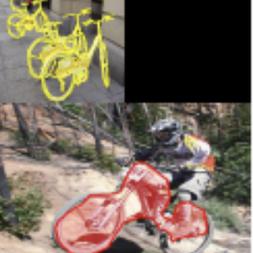Semantic Segmentation
5248 papers with code • 125 benchmarks • 312 datasets
Semantic Segmentation is a computer vision task in which the goal is to categorize each pixel in an image into a class or object. The goal is to produce a dense pixel-wise segmentation map of an image, where each pixel is assigned to a specific class or object. Some example benchmarks for this task are Cityscapes, PASCAL VOC and ADE20K. Models are usually evaluated with the Mean Intersection-Over-Union (Mean IoU) and Pixel Accuracy metrics.
( Image credit: CSAILVision )
Libraries
Use these libraries to find Semantic Segmentation models and implementationsSubtasks
-
 Tumor Segmentation
Tumor Segmentation
-
 Panoptic Segmentation
Panoptic Segmentation
-
 3D Semantic Segmentation
3D Semantic Segmentation
-
 Weakly-Supervised Semantic Segmentation
Weakly-Supervised Semantic Segmentation
-
 Weakly-Supervised Semantic Segmentation
Weakly-Supervised Semantic Segmentation
-
 Scene Segmentation
Scene Segmentation
-
 Semi-Supervised Semantic Segmentation
Semi-Supervised Semantic Segmentation
-
 Real-Time Semantic Segmentation
Real-Time Semantic Segmentation
-
 3D Part Segmentation
3D Part Segmentation
-
 Unsupervised Semantic Segmentation
Unsupervised Semantic Segmentation
-
 Road Segmentation
Road Segmentation
-
 One-Shot Segmentation
One-Shot Segmentation
-
 Bird's-Eye View Semantic Segmentation
Bird's-Eye View Semantic Segmentation
-
 Crack Segmentation
Crack Segmentation
-
 UNET Segmentation
UNET Segmentation
-
 Universal Segmentation
Universal Segmentation
-
 Class-Incremental Semantic Segmentation
Class-Incremental Semantic Segmentation
-
 Polyp Segmentation
Polyp Segmentation
-
 Vision-Language Segmentation
Vision-Language Segmentation
-
 4D Spatio Temporal Semantic Segmentation
4D Spatio Temporal Semantic Segmentation
-
 Histopathological Segmentation
Histopathological Segmentation
-
 Attentive segmentation networks
Attentive segmentation networks
-
 Text-Line Extraction
Text-Line Extraction
-
 Aerial Video Semantic Segmentation
Aerial Video Semantic Segmentation
-
 Amodal Panoptic Segmentation
Amodal Panoptic Segmentation
-
 Robust BEV Map Segmentation
Robust BEV Map Segmentation
Latest papers
GLIMS: Attention-Guided Lightweight Multi-Scale Hybrid Network for Volumetric Semantic Segmentation
Notably, GLIMS achieved this high performance with a significantly reduced number of trainable parameters.
Multi-Scale Representations by Varying Window Attention for Semantic Segmentation
VWA leverages the local window attention (LWA) and disentangles LWA into the query window and context window, allowing the context's scale to vary for the query to learn representations at multiple scales.
A Multi-objective Optimization Benchmark Test Suite for Real-time Semantic Segmentation
To bridge the gap, we introduce a tailored streamline to transform the task of HW-NAS for real-time semantic segmentation into standard MOPs.
Multimodal Information Interaction for Medical Image Segmentation
To address this issue, we introduce an innovative Multimodal Information Cross Transformer (MicFormer), which employs a dual-stream architecture to simultaneously extract features from each modality.
Boosting Unsupervised Semantic Segmentation with Principal Mask Proposals
Unsupervised semantic segmentation aims to automatically partition images into semantically meaningful regions by identifying global categories within an image corpus without any form of annotation.
Self-Balanced R-CNN for Instance Segmentation
Current state-of-the-art two-stage models on instance segmentation task suffer from several types of imbalances.
Auto-Generating Weak Labels for Real & Synthetic Data to Improve Label-Scarce Medical Image Segmentation
The high cost of creating pixel-by-pixel gold-standard labels, limited expert availability, and presence of diverse tasks make it challenging to generate segmentation labels to train deep learning models for medical imaging tasks.
OMEGAS: Object Mesh Extraction from Large Scenes Guided by Gaussian Segmentation
Current scene reconstruction techniques frequently result in the loss of object detail textures and are unable to reconstruct object portions that are occluded or unseen in views.
Vision Transformer-based Adversarial Domain Adaptation
Unsupervised domain adaptation (UDA) aims to transfer knowledge from a labeled source domain to an unlabeled target domain.
Surgical-DeSAM: Decoupling SAM for Instrument Segmentation in Robotic Surgery
We utilise a commonly used detection architecture, DETR, and fine-tuned it to obtain bounding box prompt for the instruments.






























































































































 MS COCO
MS COCO
 Cityscapes
Cityscapes
 KITTI
KITTI
 ShapeNet
ShapeNet
 ScanNet
ScanNet
 ADE20K
ADE20K
 NYUv2
NYUv2
 DAVIS
DAVIS
 SYNTHIA
SYNTHIA
 EuroSAT
EuroSAT
